
W3SZ 10 GHz EME page

It all started in February 2006 when Steve Kerns, N3FTI decided to get out of the roving business
and sell off some of his UHF and Microwave equipment. I had vaguely been considering trying to get on 10 GHz EME some day, and when I saw that 10 GHz TWTs were a part of his sale items, I decided to start accumulating. I obtained some nice 5-10 GHz Siemens TWTs from him as well as his very nice "Rover Box", which had inside and already wired up and ready to go one of the TWTs as well as bandswitching, TR switching, and 5 and 10 GHz Transverters and receive preamps from Down East Microwave.
Then, in the spring of 2007, Steve decided to sell his 8.5 foot Birdview dish and mount, and so I got both of those from him.
Things got really busy for me with work and family "stuff", so I put my thoughts of 10 GHz EME on the back burner. I didn't really have a good place to put up the dish, anyway. I figured I would get to it after I retired from work in a few years, and so I stored the dish in my garage/workshop.
I thought about doing a temporary, portable installation with the dish mounted on a trailer so that I could drive it down to a clearing in my Hilltop country property (which is otherwise heavily forested) when I wanted to operate 10 GHz EME, but I wasn't sure that was a practical thing to do. I figured I could use a short tower section and a tilt-base mounted on the trailer to support the dish, but never having done anything at all like this kind of installation I wasn't confident this could be accomplished with reasonable expenditures of time and money.
Then I read an excellent article by Rick Rosen, K1DS, that was published in the proceedings of the 2010 14th International EME conference entitled "There's No Such Thing as a Free Dish", and a brief follow-up article in the PackRats' November 2010 Newsletter [go to page 7] describing Rick's journey to create a portable 1296 [and 432] MHz EME installation that was almost exactly along the lines of what I had been thinking about. Rick had done it and it worked! I was really excited about this and I emailed Rick for more information, and he sent me lots of great information and pictures, and even drove up from the Philadelphia area to my site and gave me more information and encouragement first-hand. After that I felt for the first time that I really could do this!
That was in October 2010, and at that time I decided to start working towards getting on 10 GHz EME.
My goal was to be operational by the 2011 ARRL International EME contest.
Today [Saturday, September 25, 2011] I made my first 10 GHz EME contact, "right on schedule" on the first day of the 2011 ARRL International EME contest, working W5LUA. Unfortunately, I didn't make a recording of that contact. But I did make a recording of DL0EF, whom I called and called before I worked Al. I was too weak to complete with DL0EF, getting only a "very poor" and "219" back from him after many, many QRZ's from him. I guess I need MORE POWER ;) DL0EF and Al W5LUA were the loudest stations on the band. Both were Q5, 100% copy. I gave DL0EF a 579, and Al was 559.
The next day I did work DL0EF, who has a TREMENDOUS signal. On the second day, I had not yet "found the moon" and was hunting around "where it should be" looking for an increase in moon noise when I saw a huge signal on the HPSDR bandscope. I figured it must either be a huge birdie [of which I have none] or DL0EF. Fortunately, it was DL0EF and I was off to the races. I worked him a short time later.
Here is a wav file of DL0EF dl0ef-10GhzEME-9-24-2011.wav from day one [12 MB file].
Here is DL0EF in QSO with WA6PY from day two DL0EFandWA6PY9-25-2011-10GHz.wav [62 MB file].
I also made a recording of DL0EF while he was in SSB QSO on 10 GHz EME! He was good copy. Here it is.
Because of libration, the 10 GHz EME signals may have an auroral or rain-scatter like quality. This smearing seems to peak near zenith, at the point where Doppler shift is minimal. The "libration" URL just referenced above goes into the theory and predictability of this effect. You can see the frequency distribution and thus get some idea of the effect of libration on DL0EF's CW signal on day one on these spectra:



I am currently operating "portable" on my "Hilltop" property, towing the 10 GHz EME setup which I have mounted on a trailer to the clearing when I want to operate, and putting it inside when done. Things are not yet waterproofed, so I am a "fair weather" EMEer on 10 GHz.
Also, I have not finalized or fully calibrated the Az/El drive system, and it is difficult for me to accurately know the Azimuth heading to within a degree when I park the trailer. For these reasons I thought I would need to see the moon to get started, because the beamwidth of my dish is less than 1 degree and I figured that I would never get close enough to the correct Az and El to find the moon with such a narrow beamwidth. On day one of the ARRL contest the moon was totally clouded over, and so I thought all was lost, but I found the moon by going to where is "was supposed to be" and actually found it by the moon noise. Once I found it I was able to track it manually using the moon noise, which was approximately 1 dB. On day two, DL0EF's huge signal came to the rescue, and I found the moon by seeing it on the bandscope, and then peaking on it, even before I found the moon noise. On both days, once I found the moon noise I was able to follow the moon across the sky by repeatedly peaking the moon noise by jogging the Az and El positions. Of course, if DL0EF was always on the air I could always easily find the moon!
I am using a classic "Birdview" satellite dish with its companion rotator. The Birdview Az/EL system is "Az over El" and this creates a number of issues which I won't repeat here. Go the the hyperlink if you want to know more.
The 28 MHz IF radio is an HPSDR software defined radio, and in parallel with it I run an SDR-IQ and its companion SpectraVue software [the latter operating in "Right to Left Continuum Mode"] to watch the moon noise [or sun noise when testing and tuning], as Al Ward W5LUA recommended to me at Dayton this past Spring. The SDR-IQ is essential to tracking the moon, and its use to measure sun noise was essential to setting up the system properly when adjusting the distance between the feed and the dish. Keeping a regular log of the sun noise allows me to monitor system performance.
The IF radio is followed by a Low Power 28-144 Transverter
from
Down East
Microwave, which is followed by a
Down East
Microwave 144-10368 Transverter. On receive I have a second stage
Down East
Microwave 10 GHz receive preamplifier, and on transmit I have a
Siemens RW1125G TWT. These are connected to
the dish via [1] a short run of miniature hardline which runs
from
the T/R switch immediately after the second stage preamp and TWT to a WR75-to-N adapter,
[2] followed by 6 feet
of flexible WR75 waveguide, [3] followed by 12 feet of Andrew EW122 elliptical waveguide,
which is connected to the waveguide switch at the feed. I measure 1.3 dB
loss between the T/R switch at the Transverter/TWT/2nd stage
preamp and the WR75 flange at the feed after the waveguide switch. My sun noise is
usually 12 dB with my 8.5 foot Birdview dish and the
Chaparral Feed [pages
15-22; also, here is a
picture of mine], with a modified JRC LNB at the waveguide switch used as the first stage
preamp. I have 25 watts measured transmit power at the feed. For tracking I use
Northern Lights Software Associates'
Nova software feeding a homebrew
Visual Basic program that converts the standard "Az and El" coordinates to what I need with my Birdview
Az over El dish/drive system, as explained on the web page referenced above as "issues".
This Visual Basic program, which masquerades as SM-Trak [so it can work with
the DRZTrack via DDE], then sends the new
numbers to DRZTrack 2.11a by
K2TXB, which is the software for W2DRZ's excellent
W2DRZ Controller Board,
which drives the Birdview dish Azimuth motor and Elevation actuator. Both
Russ, K2TXB and Tom, W2DRZ were EXTREMELY helpful to me in getting things going.
Thanks, guys! The
weak link in this system is the original Birdview mechanical Az and El hardware,
which was not
made for positioning with better than 1 degree accuracy, which is what is needed
here. A light tap on the switch, as brief as I can do, was enough to cause
the motors to move the dish from one side of its beam width to the other.
I have gotten a significant improvement in positioning capability by adding PWM speed controls to my
setup. By dialing back the
pulse width I have much better control over fine movement of both Az and
El. eBay to the rescue once again! The W2DRZ Controller itself provides extremely fine position
control so it will be anxiously awaiting improvements in the mechanics! After writing the above, I have changed the first stage receive
preamp at the waveguide switch to a
Kuhne MKU LNA 102 S EME, and the second stage preamp to a
Kunhe MKU LNA 102 B. This increased sun Y factor from 12 to 13.5 dB.
I may also
eventually increase transmit power as well. With this hardware I get 1.2 - 1.3
dB moon noise. Note that my Y factor and moon noise reports are
conservative, as I measure object noise relative to the sky out of the beam
width of the dish, but not relative to actual "cold sky". Thus my Y factor
and moon noise are likely better than I report, and certainly no worse. There is still lots to do, but I am very happy to have made a
couple of
actual 10 GHz EME contacts!
Future plans include first of all waterproofing the feed, waveguide, and
electronics, so that I am not limited to fair weather operation. After
that my next
step will be modifying the dish support and the Az and El
drive to provide El over Az and horizon-to-horizon
azimuth range. The Birdview Azimuth rotator is limited to 130 degrees rotation.
My feed support is made of "toilet rings" from PaulB [Zimmerman Hardware] of Ephrata, PA. This is in the heart of Amish Country. Russ Lamm, NN3Q told me I "had" to go to PaulB's when I showed him what I was trying to do, and he even drove me out there. We walked into PaulB's with my Chaparral feed and I approached one of the associates and I told him that I needed something to make a mount for "this", holding up the Chaparral feed, and the very helpful gentleman said "It looks like you need some toilet rings" and led us over to the toilet rings, and that was that. Here is the "toilet ring" feed assembly with toilet rings visible at top and bottom, courtesy of Russ NN3Q and PaulB's:
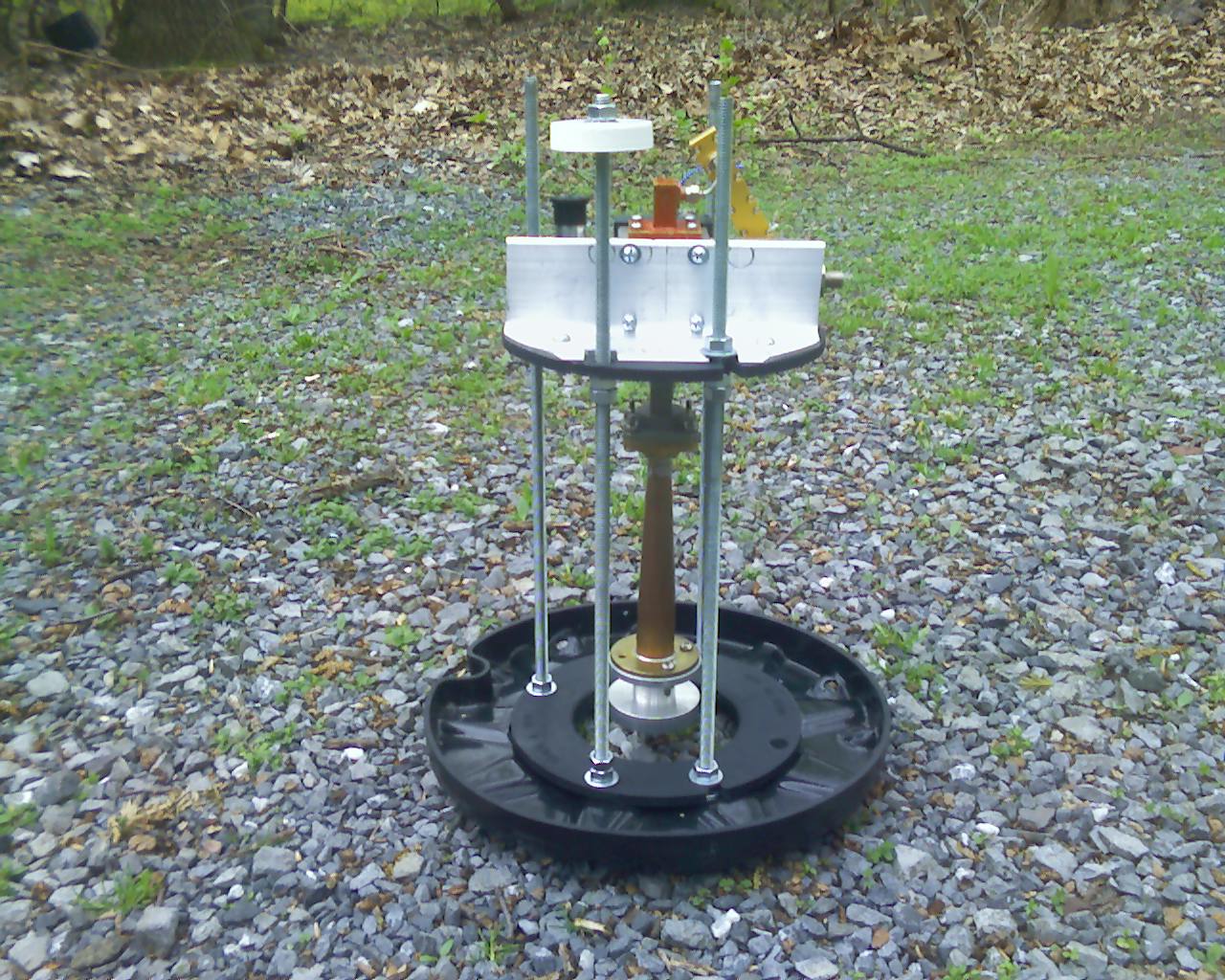
I have been back to PaulB's several times since that trip, even taking my son, who is senior in Mechanical Engineering at my alma mater RPI and my wife to show them its glory [on separate trips]. My son was more impressed with PaulB's than was my wife. If you visit PaulB's, you must stop at either the Evergreen Diner or The Udder Choice...or both. Simple fare, but real Lancaster County. The Udder Choice is also popular with tourists, so time your trip accordingly.
Below are some little details of the process I went through "for the next guy" who travels this road...
The Birdview dish has a diameter of 8.5 feet and a height "s" of 16.25 inches, so by the formula from The ARRL UHF/Microwave Experimenter's Handbook:
f/D = D/(16 * s)
= 102/(16 * 16.25)
= 0.3923
the focal length = 102 * 0.3923 = 40.015 inches [1024 mm]. I have found that the sun noise Y factor seems to be flat from 1008 to 1027 mm. I ended up using a focal length of 1016 mm because that was where it was when I finished my testing. The reference given here, to an article by VK3UM is extremely helpful not only in explaining how to measure sun noise, but also telling what to do with the results.
I aligned the feed using a laser pointer wrapped with electrical tape so that it would be a snug fit in the feed bore. I just turned on the laser pointer when it was nestled snugly in the bore of the feed, and if the red dot was not exactly in the center of the dish, I adjusted the feed mount until it was so. I don't have a good picture of the laser pointer in action, so here is a crummy picture of it sitting on an anti-static mat:
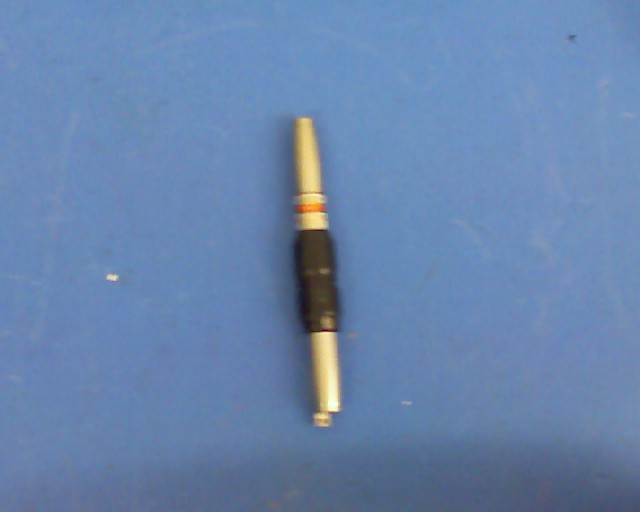
The waveguide transfer switch at the feed has an extra set of "indicator" contacts, that gives feedback on whether the switch is in Transmit or Receive position. I use these to provide a lockout to the PTT, so that the system cannot go into transmit unless the switch is actually in the Transmit position. This is of course to protect the first stage receive preamplifier, which is mounted at the waveguide switch, from being blasted with 25 watts of RF.
I rigged up a CCD camera mounted to the dish assembly to help me align the dish with the moon, but so far I haven't used it because it was overcast and nearly "new moon" this past weekend when I made my first attempted QSOs, so there was no moon to see. When checking sun noise, I place one each #10 and #5 welding glass over the camera, and then I have just the right amount of light coming through to see the sun without damaging anything. I display the image on my computer screen by using a Hauppauge USB-Live camera adapter. When the dish is right on the sun or moon that celestial object is in the center of the screen when the camera is fully zoomed in. You can see the camera in this photo, at about 1 o'clock on the dish:
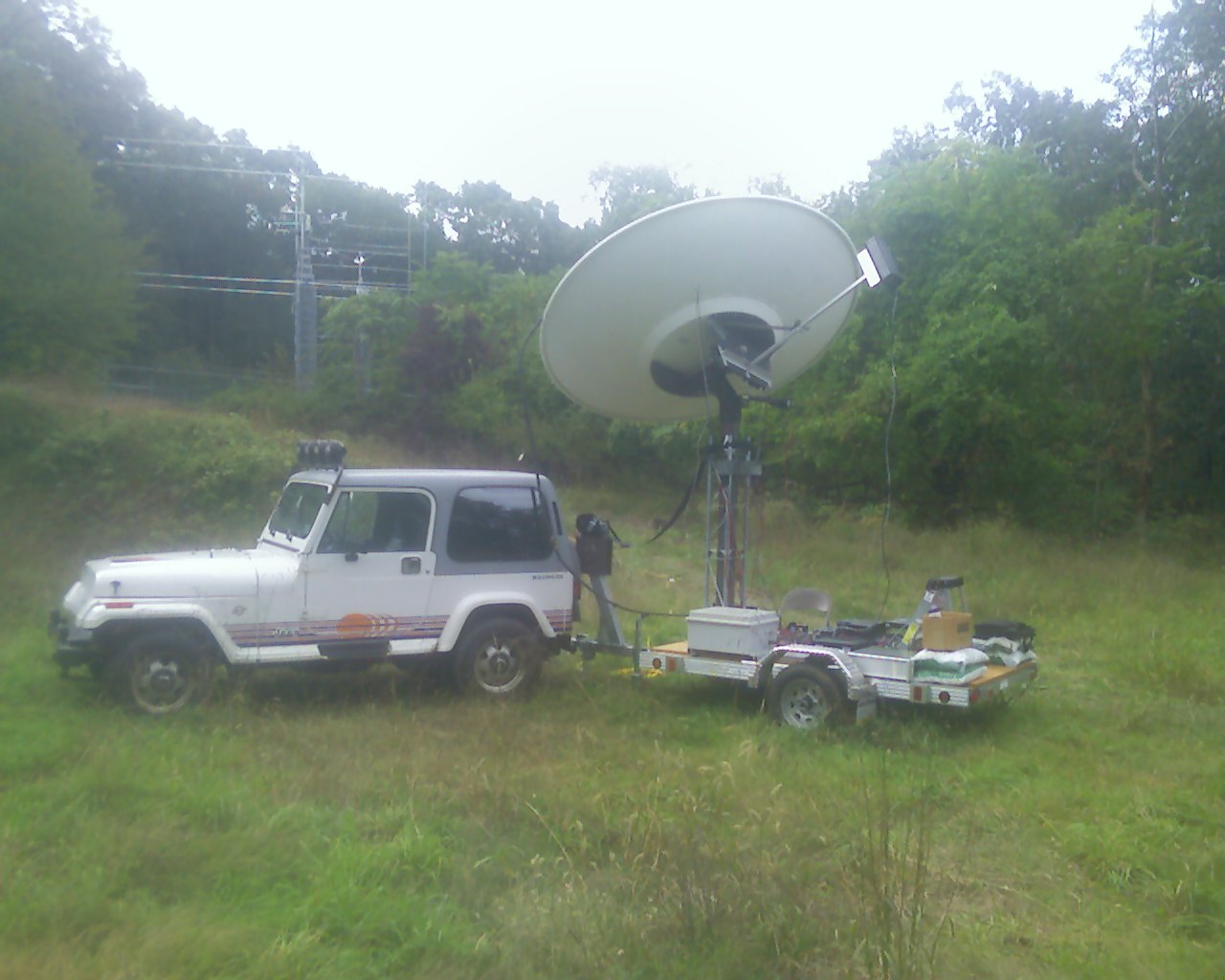
The trailer itself is a Worthington WT58 from Keystone Trailers. The dish pedestal is a 6 inch SCH 40 A-500 ERW Structural Carbon Steel Pipe, 6 foot length that I ordered online from Metals Depot. It is welded to a Rohn BPH25G Hinged Baseplate which is bolted to the trailer, and placed inside a Rohn SB25G5 Rohn 25G Short Base 5'-predrilled from 3Star, Inc. [I ended up getting 7 foot section cut down to 5 feet as that was cheaper, since 3Star cut and drilled it at no charge]. Two AS25G accessory shelves are attached to the tower section and cut so the runs through them, and the pipe is also welded to them. The Birdview dish mount is fastened to the top of the 6 inch pipe.
The dish assembly is stored and transported tilted over [but not flat, as then I would be unable to lift it to its erect position] and supported near the dish end by a 24 inch step ladder. It is pulled erect from this position by means of a boat trailer winch attached to the tongue of the trailer. Note that I used carbon steel plate to fasten the boat winch to the winch mount. Aluminum plate did not do so well. The no-longer-in-use aluminum bottom plate shown here used to be straight, not angled upwards at nearly 45 degrees!
4-50 lb bags of stone are moved from the back of the trailer to the front or vice versa to balance the load on the trailer. The stone is placed at the front of the trailer when the dish is "laid over" and at the back when it is erect. You can see the bags of stone at the back of the trailer on the picture above, and at the front of the trailer at the right bottom of the picture below, where the dish is in it storage position, tilted over:

The picture below shows the station setup for 10 GHz operation. I just got out of the chair after working DL0EF and stepped back to take this shot:
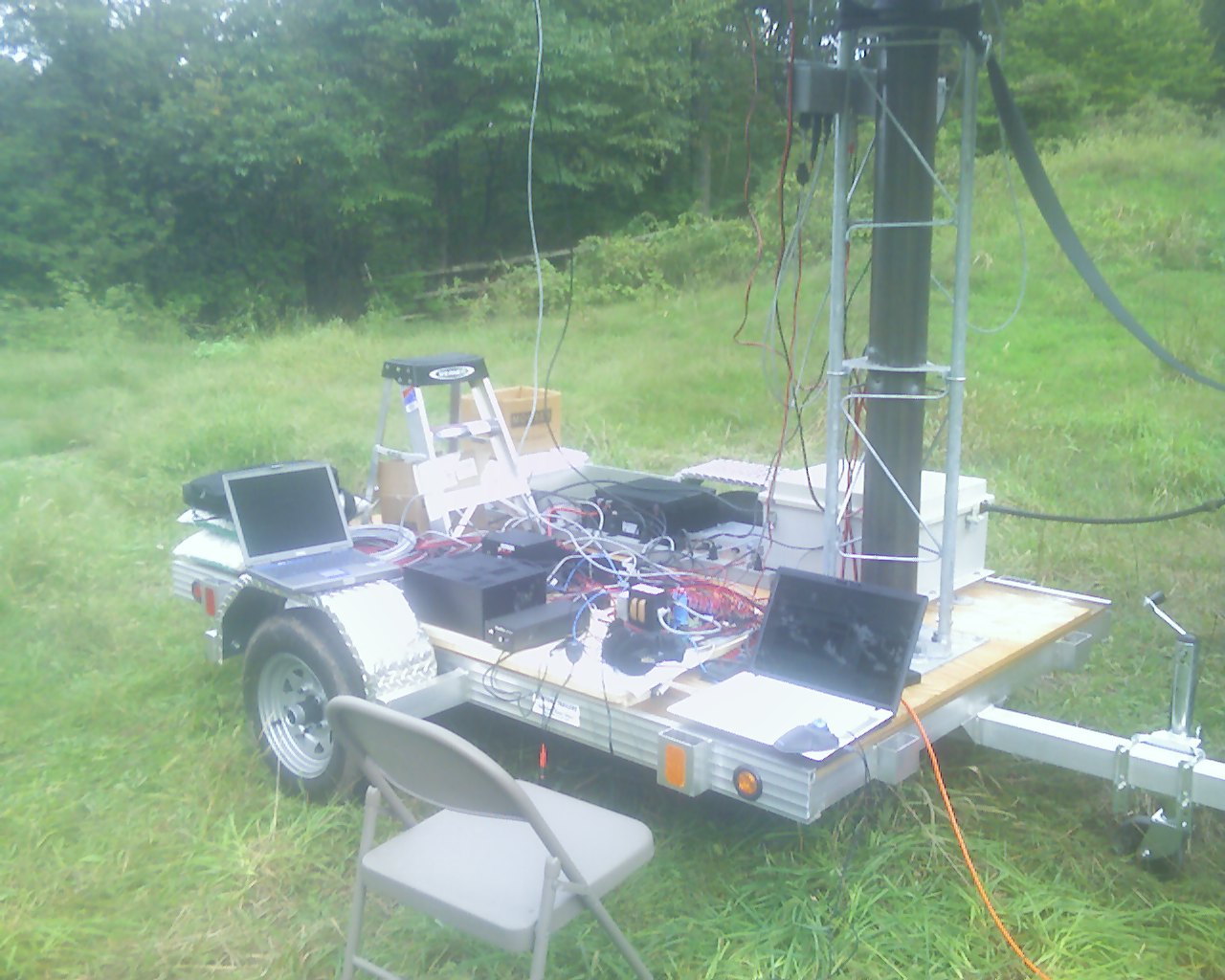
This picture is from the other side of the trailer:
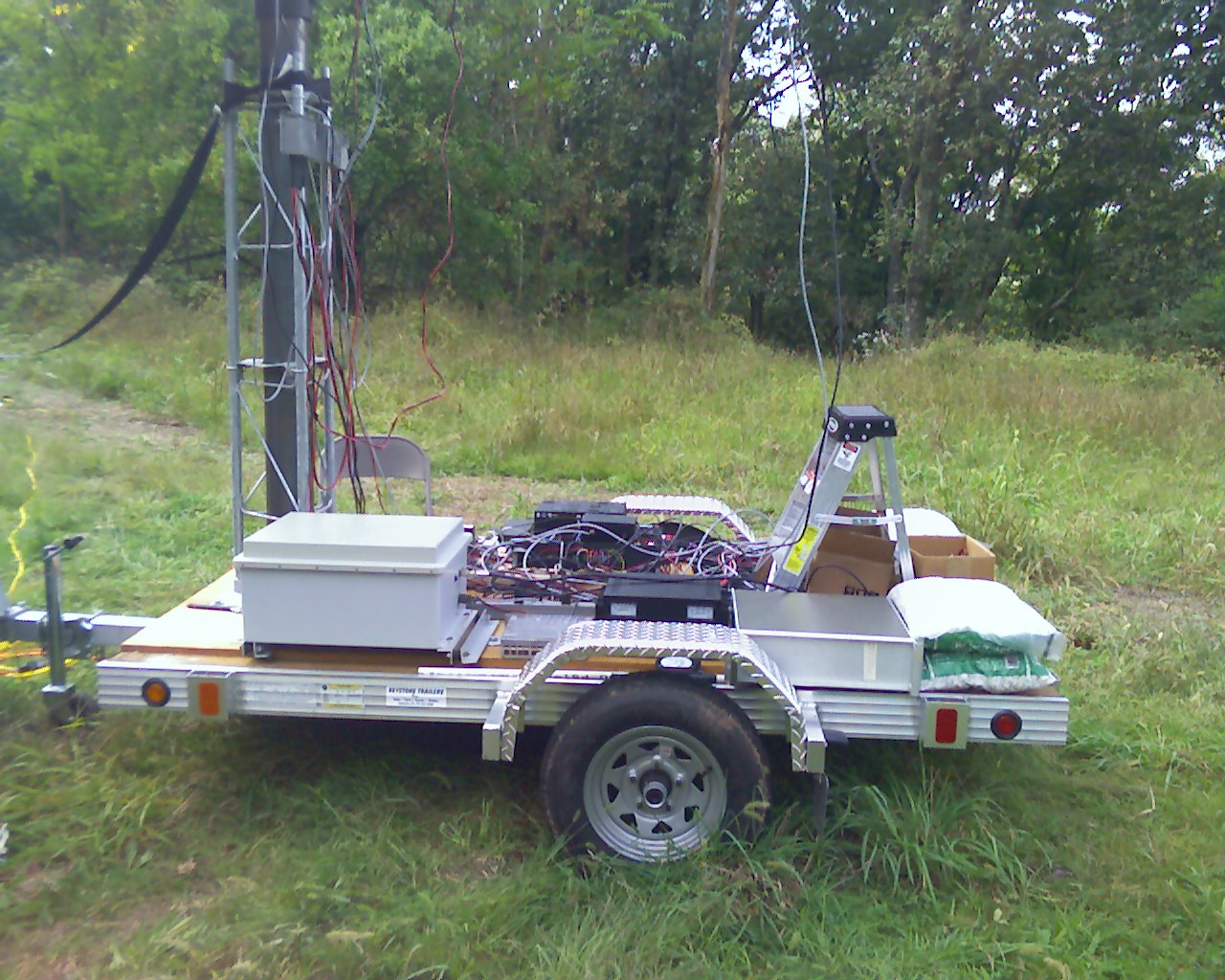
Here is a screen grab taken while I was listening to DL0EF:

Along the top you have from left to right: PowerSDR CW window, W3SZTrakSM program that takes the Az/El data from Nova and converts it to Az over El numbers, and DRZTrack. Below on the left is PowerSDR modified by me to use large FFTs [with DL0EF's signal clearly visible on both the spectrum and the waterfall] and on the right SpectraVue SDR-IQ software in "Right to Left Continuum Mode", watching the moon noise. Nova is running in the background. W3SZTrakSM also displays the Doppler shift as well as the degradation caused by rotation of the feed polarization angle due to the Az over El rotator system. The latter information is hidden behind the PowerSDR window. Here is the W3SZTrakSM window brought to the front and shown alone:

The computer is a super-duper laptop designed for best SDR performance [Low latency] that I got from Neal Campbell at Abroham Neal Software Products. He didn't sell too many of them, so it is now a special order item. It is terrific! If you are interested, contact him via his website.
Just in case you aren't bored yet, there are additional random pictures of this adventure here.
March 31, 2012: I was able to get some time off and, for the first time in 6 months, set up the system for a few hours. I heard and worked DL7YC and LX1DB. Both Manfred and Willi had very nice signals. I was also able to hear my own echos. Here is a wave file of LX1DB calling CQ on 10 GHz.
April 2, 2012: Philippe F2TU was kind enough to get on the air so I could work him. The contact was very difficult at my end due to gusty winds ranging from 0 to 40 kph that were blowing the dish all over and pushing the moon in and out of the beamwidth of the dish. Nevertheless, Philippe was very patient and we completed the contact. Here is a 3 MB file of F2TU received at W3SZ. I missed recording the beginning of the QSO.
April 29, 2012: Ronny SM7FWZ and I completed a nice, quick 10 GHz EME QSO, in spite of gusty winds. I didn't get to make an audio file. But just after we completed the QSO, I did snap a picture of the dish looking at the moon. The moon is visible as a tiny white dot located just to the right of the video camera.

Thanks for reading this! Let me know if you have questions, comments, or corrections!

Copyright 1997-2011 COPYRIGHT Roger Rehr W3SZ. All Rights Reserved
Brought to you by the folks at W3SZ